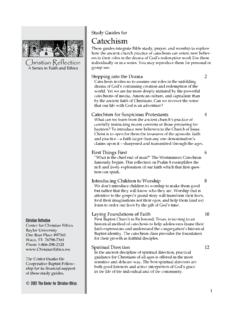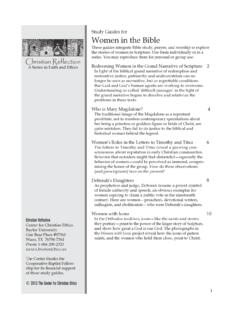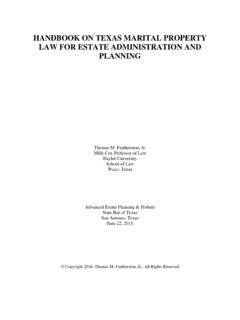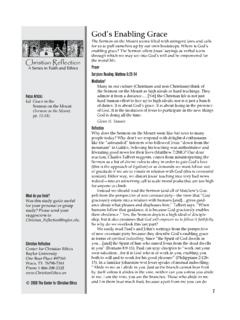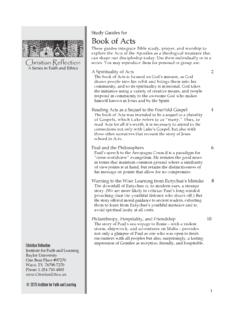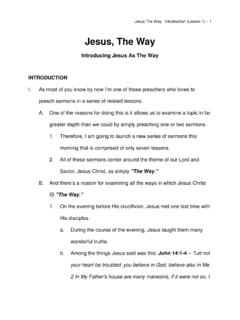Transcription of Walking the Walk (of the Stations of the Cross) - baylor.edu
1 2013 The Center for Christian Ethics at baylor University 55 Walking the Walk (of the Stations of the Cross) By Carmen aCevedo ButCherWalking the Stations of the cross a devotional path of reflection and repentance based on events in the passion and resurrection of Christ is being adapted in creative ways today. how did this form of spiritual pilgrimage originate and why is it important for our discipleship? Anglo-Saxons knew winters so bitter that writers reckoned years by their island s mettle-testing season: the Anglo-Saxon Chronicle declares one king fifty winters old, the Beowulf poet writes that Grendel terrorized Hrothgar s kingdom for twelve winters, a 1000 English translator of the Gospel of John describes the temple as built in forty-six winters (John 2:20), and the Old English poem The Wanderer says that no one becomes wise before experiencing a deal of winters in this world.
2 1 Even a twenty-first-century December with central heating can seem forever. By January, eyes scan the cold, lifeless soil for tightly folded purple crocuses waiting to open into spring s promise, just as souls numb with anxiety and dark from pain crave the pilgrimage toward eternal light and Lent, Christians express such yearnings by Walking the Stations of the cross alone or in groups, on Lenten Fridays, on Good Friday, and at other times during Holy Week. Many walk the Stations regularly through the year. This ancient devotional exercise commemorating the death and resurrection of our Lord jesus Christ is also called the way of the cross (Via Crucis) and the way of sorrow (Via Dolorosa). Over the years it has had from five to thirty-plus Stations , until 1731, when Pope Clement XII set the number at fourteen. Its tab-leaux of Christ s passion painted, engraved, carved, or sculptured, using stone, wood, or metal create a literal prayerful path that helps spiritual seekers put on Christ s sandals as they move slowly from station to station, reflecting on his life.
3 56 Lent For centuries, Episcopal (Anglican) churches have also observed these Catholic Stations of the cross, and more recently Lutherans, Presbyterians, and other Protestant churches do. Evangelicals have begun incorporating variations of these Stations into their worship services, too. A website for the interactive Passion Week Experience started by Houston s 58,000-member Second Baptist Church in 2011 describes the experience as not a traditional a fresh take on an ancient practice. 2 Its eight Stations display replicas of items associated with the betrayal and crucifixion of jesus ; in 2012, thousands touched a crown of thorns, smelled bottles of spices, held pieces of silver, and nailed their sins to a large cross. YChristians have always wanted to visit the Holy Land to walk in Christ s steps from the Garden of Gethsemane, through the high priest s courtyard, by Pilate s house, through Jerusalem, out to the hill of crucifixion (Calvary/Golgotha), and to the tomb.
4 After Constantine legalized Christian worship in the Roman Empire in 313, the Basilica of the Holy Sepulcher was erected on the location believed to have been Christ s tomb, becoming popular with pil-grims. The late-fourth-century Galician pilgrim Egeria described the fervency of these pilgrimages: at the hour of cockcrow, she, a bishop, and two hundred others walked to Gethsemane singing hymns and there listened to the Gospel passage on the Lord s arrest, after which she heard such moaning and groaning with weeping from all the people that it echoed practically as far as the city. 3 A winding route emerged over time from the ruins of Antonia Fortress, held to be where jesus stood before Pilate, then west to the basilica; the Via Dolorosa has seen alternative routes through the years because of diverse opinions on the locations of Christ s walk to the Eventually stops developed, and in 1342, Franciscan monks were given official custody of these holy sites, closely identifying them with the Stations from then the first surviving narrative by the anonymous early-fourth-century Pilgrim of Bordeaux to the famous travelogue-memoir dictated by fifteenth-century Margery Kempe, Holy Land pilgrimages make fascinating reading, but not all aspiring pilgrims could manage this arduous, costly trip.
5 Therefore, pictures or sculptures representing stages of Christ s journey to the cross were erected in or near local churches or other public venues, and medieval practi-tioners of the Stations Starting in the fifteenth century, open-air Via Dolorosa processions occurred throughout Europe, made concrete by measur-ing actual distances in Jerusalem and setting up memorials at relevant As a spiritual exercise, the Stations of the cross developed organically from the scripturally focused lives of medieval followers. Because vibrant devotional sources developed with unsystematic abundance in response to the gospel of jesus , a linear history of this practice remains unclear, but we can witness its foundation of biblical meditation in the influential, widely read works of Birgitta of Sweden, a fourteenth-century noble woman, mother Walking the Walk (of the Stations of the Cross) 57of eight, monastic religious order founder, and contemplative who ruminated all her life on Christ s Only in her seventies did Birgitta make it to Jerusalem to retrace Christ s steps; but her lifelong daily Bible meditations informed her Revelations (inspiring the fifteenth-century English pilgrim and mystic Margery Kempe, for one), and these possess remarkable realism: At the command of the executioner, [Christ] undressed Himself and freely hugged the pillar.
6 He was bound with a rope and then scourged with barbed whips. The barbs caught in His skin and were then pulled backward, not just tearing but plowing into Him so as to wound His whole body. At the first blow, it was as though my heart had been pierced and I had lost the use of my s Prayers also invite reflection on Christ s suffering:Infinite glory to You, my Lord jesus Christ! For us, You humbly endured the Cross. Your holy hands and feet were stretched out with rope. Your hands and feet were secured with iron nails to the wood of the cross, cruelly. You were called, Traitor! You were ridiculed in many ways.. Eternal praise to You, Lord, for each and every hour You suffered such terrible bitterness and agony on the cross for us sinners!9 Another writer who ruminated on Christ s passion is the sixteenth-century Dutch geographer and priest, Christian van Adrichem. Never pilgrimaging to the Holy Land, he drew from both a richly meditative life and circulating stories to craft accounts of Christ s walk to Golgotha.
7 His narrative was translated throughout Europe and became another significant source for the devotion to the way of the This excerpt from Urbis Hierosolymae (City of Jerusalem) demonstrates Adrichem s meticulous style:The Way of the Cross which Christ, after he had been condemned to be crucified, followed with the most wretchedly suffering and bloody footsteps, to Mount Calvary. Beginning at Pilate s palace, he walked 26 paces, or 65 feet, to the place where the Cross was placed upon his shoulders. Thence, while the whole city looked on, bearing the as a spiritual exercise, the Stations of the cross developed organically from the scripturally focused lives of medieval followers. Since vibrant devotional sources developed with unsystematic abundance, a history of the practice remains unclear. 58 Lent Cross on his pained shoulders he turned in a northwestern direction and walked towards the place where, according to tradition, he stumbled for the first time under the weight of the Cross; this is a distance of 80 paces.
8 200 feet. Thence he proceeded for 63 paces 153 feet to the spot where he encountered Mary his mother and the disciple John. From that place he continued 71 paces and 1 feet 179 feet to the fork in the road where Simon of Cyrene was forced to walk behind jesus , carrying his Cross for Thence the 18 paces or 45 feet to the place where the executioners removed his clothing; and there he drank wine mixed with myrrh. After that 12 paces or 30 feet to the place where he was nailed to the Cross. Finally from that point the 14 paces or 35 feet to the place where, hanging upon the Cross, he was set in a hollow in the rocky ground of Calvary. Thus from the palace of Pilate to the place where the Cross was raised it was 1321 paces or, according to the other calculation, 3303 an epilogue, Adrichem reminds readers that they may follow this way of the cross in templo seu cubiculo mentis ( within the temple or chamber of the spirit ), without leaving home.
9 As Medieval scholar Dee Dyas points out, The aim of the true pilgrim was not in the final analysis to see Jerusalem but to see seek an interior Jerusalem . 12 YNo longer associated with the corrupt indulgences of the Middle Ages, Walking the Stations is increasingly embraced by Christians of all denomi-nations seeking an interior Jerusalem where we can know God as more inward than [our] most inward part, as Augustine Following in countless footsteps from station to station, post-postmoderns connect in a profoundly transformative way with the stages of Christ s earthly journey. Station is a term often credited to fifteenth-century British pilgrim William Wey and is rooted in the Latin for to stand. Stations are places where we stop and be still, waiting for a bus, taxi, or train, in transit to somewhere else. Similarly, in this life, we are always waiting on God, en route to heaven.
10 The exercise of the Stations helps us develop empathy for others who are waiting beside Stations have existed over the centuries, including extra-biblical ones based on inferences from the gospel and on legend. Asterisks below indicate the six non-scriptural Stations in the traditional sequence:1. jesus is condemned to jesus is handed his cross. 3. jesus falls for the first time.*4. jesus meets his mother.*5. Simon of Cyrene is required to carry jesus s cross. Walking the Walk (of the Stations of the Cross) 596. Veronica wipes the face of jesus .*7. jesus falls a second time.*8. jesus meets the women of jesus falls a third time.*10. jesus is stripped of his clothes. 11. jesus is crucified. 12. jesus dies on the cross. 13. jesus s body is taken down from the cross.*14. The body of jesus is placed in the John Paul II shifted the makeup of the Stations away from legend and toward a solely scriptural foundation, dropping from this traditional list those six non-scriptural Stations and adding ones from Gospel accounts of Christ s life (asterisked below).


